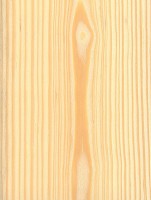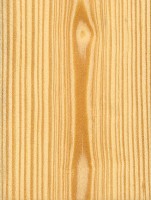 |
Common Name(s): Khasi Pine, Benguet Pine Scientific Name: Pinus kesiya (syn. P. insularis) Distribution: India and southeast Asia; also grown on plantations in Africa and South America Tree Size: 100-130 ft (30-40 m) tall, 3-4 ft (1-1.2 m) trunk diameter Average Dried Weight: 38 lbs/ft3 (610 kg/m3) Specific Gravity (Basic, 12% MC): .45, .61 Janka Hardness: 670 lbf (3,000 N) Modulus of Rupture: 12,610 lbf/in2 (87.0 MPa) Elastic Modulus: 1,776,000 lbf/in2 (12.25 GPa) Crushing Strength: 7,330 lbf/in2 (50.6 MPa) Shrinkage: Radial: 5.1%, Tangential: 8.4%, Volumetric: 13.6%, T/R Ratio: 1.6 |
Color/Appearance: Heartwood is light reddish brown, sapwood is pale yellow and isn’t clearly demarcated from the heartwood. Color tends to darken with age.
Grain/Texture: Grain is straight, with a medium texture.
Rot Resistance: The heartwood is rated as moderate to low in decay resistance.
Workability: Overall, Khasi Pine works fairly well with most tools, though the resin can gum up tools and clog sandpaper. Khasi Pine glues and finishes well.
Odor: Khasi Pine has a mild, resinous odor when being worked.
Allergies/Toxicity: Working with pine has been reported to cause allergic skin reactions and/or asthma-like symptoms in some people. See the articles Wood Allergies and Toxicity and Wood Dust Safety for more information.
Pricing/Availability: Frequently mixed with Sumatran Pine and sold as construction lumber.
Sustainability: This wood species is not listed in the CITES Appendices, and is reported by the IUCN as being a species of least concern.
Common Uses: Paper (pulpwood), boxes/crates, furniture, and construction lumber.
Comments: Khasi Pine is grown on plantations throughout the southern hemisphere, and the fast-growing tree is utilized mainly as construction lumber.
- Austrian Pine (Pinus nigra)
- Caribbean Pine (Pinus caribaea)
- Eastern White Pine (Pinus strobus)
- Jack Pine (Pinus banksiana)
- Jeffrey Pine (Pinus jeffreyi)
- Limber Pine (Pinus flexilis)
- Loblolly Pine (Pinus taeda)
- Lodgepole Pine (Pinus contorta)
- Longleaf Pine (Pinus palustris)
- Maritime Pine (Pinus pinaster)
- Ocote Pine (Pinus oocarpa)
- Patula Pine (Pinus patula)
- Pinyon Pine (Pinus edulis)
- Pitch Pine (Pinus rigida)
- Pond Pine (Pinus serotina)
- Ponderosa Pine (Pinus ponderosa)
- Radiata Pine (Pinus radiata)
- Red Pine (Pinus resinosa)
- Sand Pine (Pinus clausa)
- Scots Pine (Pinus sylvestris)
- Shortleaf Pine (Pinus echinata)
- Slash Pine (Pinus elliottii)
- Spruce Pine (Pinus glabra)
- Sugar Pine (Pinus lambertiana)
- Sumatran Pine (Pinus merkusii)
- Table Mountain Pine (Pinus pungens)
- Western White Pine (Pinus monticola)
- Virginia Pine (Pinus virginiana)
Scans/Pictures: There are currently no pictures of this exact wood species, but a similar species within the Pinus genus is being substituted (P. sylvestris). If you’d like to contribute a wood sample of this specific species to be scanned, (even small pieces of veneer can be sent), please use the contact form.





